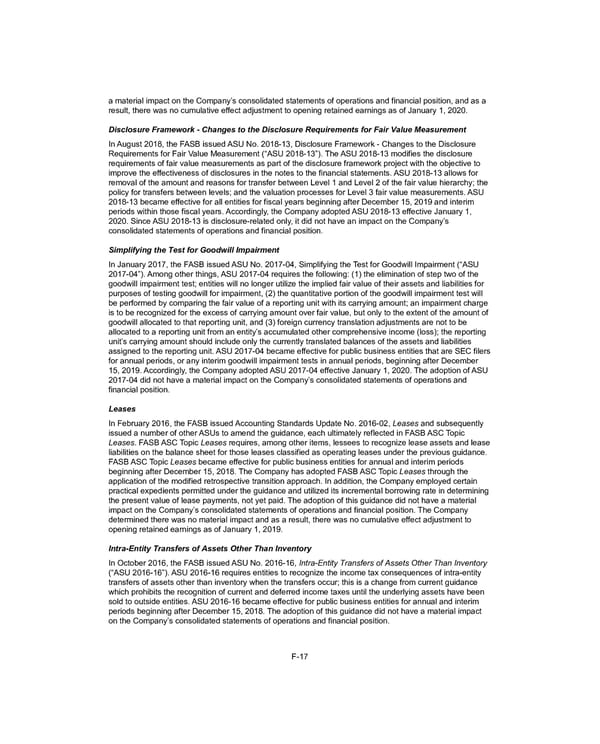a material impact on the Company’s consolidated statements of operations and financial position, and as a result, there was no cumulative effect adjustment to opening retained earnings as of January 1, 2020. Disclosure Framework - Changes to the Disclosure Requirements for Fair Value Measurement In August 2018, the FASB issued ASU No. 2018-13, Disclosure Framework - Changes to the Disclosure Requirements for Fair Value Measurement (“ASU 2018-13”). The ASU 2018-13 modifies the disclosure requirements of fair value measurements as part of the disclosure framework project with the objective to improve the effectiveness of disclosures in the notes to the financial statements. ASU 2018-13 allows for removal of the amount and reasons for transfer between Level 1 and Level 2 of the fair value hierarchy; the policy for transfers between levels; and the valuation processes for Level 3 fair value measurements. ASU 2018-13 became effective for all entities for fiscal years beginning after December 15, 2019 and interim periods within those fiscal years. Accordingly, the Company adopted ASU 2018-13 effective January 1, 2020. Since ASU 2018-13 is disclosure-related only, it did not have an impact on the Company’s consolidated statements of operations and financial position. Simplifying the Test for Goodwill Impairment In January 2017, the FASB issued ASU No. 2017-04, Simplifying the Test for Goodwill Impairment (“ASU 2017-04”). Among other things, ASU 2017-04 requires the following: (1) the elimination of step two of the goodwill impairment test; entities will no longer utilize the implied fair value of their assets and liabilities for purposes of testing goodwill for impairment, (2) the quantitative portion of the goodwill impairment test will be performed by comparing the fair value of a reporting unit with its carrying amount; an impairment charge is to be recognized for the excess of carrying amount over fair value, but only to the extent of the amount of goodwill allocated to that reporting unit, and (3) foreign currency translation adjustments are not to be allocated to a reporting unit from an entity’s accumulated other comprehensive income (loss); the reporting unit’s carrying amount should include only the currently translated balances of the assets and liabilities assigned to the reporting unit. ASU 2017-04 became effective for public business entities that are SEC filers for annual periods, or any interim goodwill impairment tests in annual periods, beginning after December 15, 2019. Accordingly, the Company adopted ASU 2017-04 effective January 1, 2020. The adoption of ASU 2017-04 did not have a material impact on the Company’s consolidated statements of operations and financial position. Leases In February 2016, the FASB issued Accounting Standards Update No. 2016-02, Leases and subsequently issued a number of other ASUs to amend the guidance, each ultimately reflected in FASB ASC Topic Leases . FASB ASC Topic Leases requires, among other items, lessees to recognize lease assets and lease liabilities on the balance sheet for those leases classified as operating leases under the previous guidance. FASB ASC Topic Leases became effective for public business entities for annual and interim periods beginning after December 15, 2018. The Company has adopted FASB ASC Topic Leases through the application of the modified retrospective transition approach. In addition, the Company employed certain practical expedients permitted under the guidance and utilized its incremental borrowing rate in determining the present value of lease payments, not yet paid. The adoption of this guidance did not have a material impact on the Company’s consolidated statements of operations and financial position. The Company determined there was no material impact and as a result, there was no cumulative effect adjustment to opening retained earnings as of January 1, 2019. Intra-Entity Transfers of Assets Other Than Inventory In October 2016, the FASB issued ASU No. 2016-16, Intra-Entity Transfers of Assets Other Than Inventory (“ASU 2016-16”). ASU 2016-16 requires entities to recognize the income tax consequences of intra-entity transfers of assets other than inventory when the transfers occur; this is a change from current guidance which prohibits the recognition of current and deferred income taxes until the underlying assets have been sold to outside entities. ASU 2016-16 became effective for public business entities for annual and interim periods beginning after December 15, 2018. The adoption of this guidance did not have a material impact on the Company’s consolidated statements of operations and financial position. F-17
 2021 Annual Report Page 159 Page 161
2021 Annual Report Page 159 Page 161